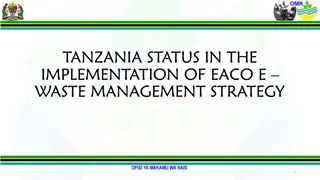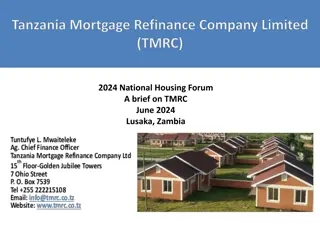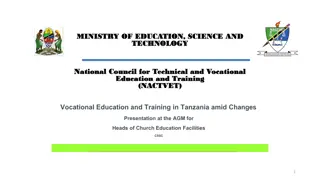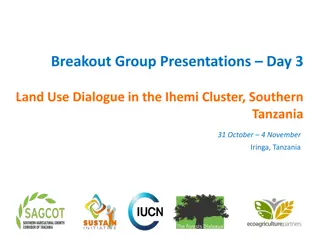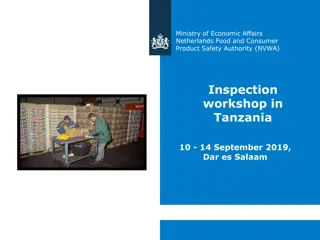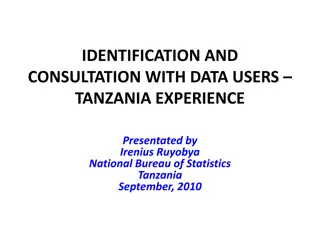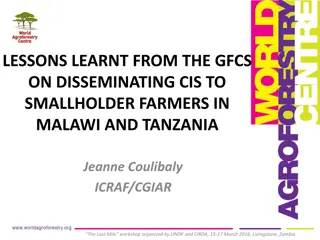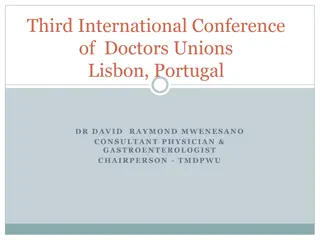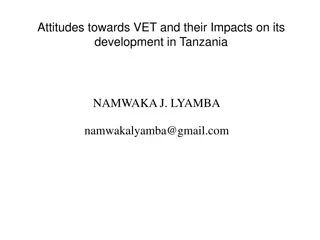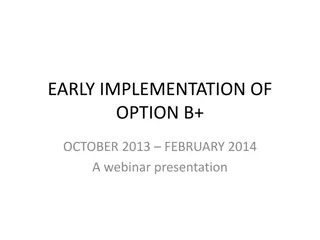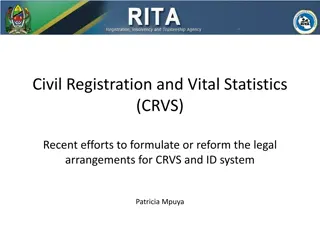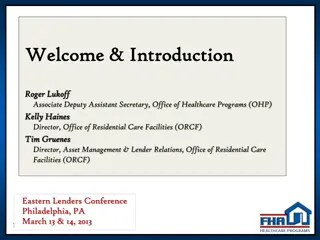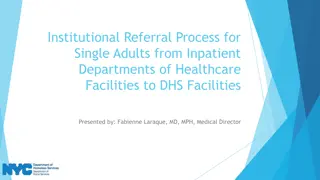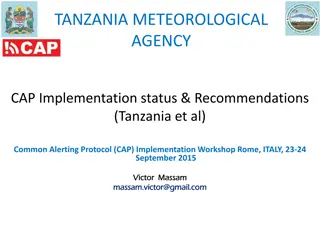Improving Healthcare Facilities in Tanzania
United Republic of Tanzania has a population of over 55 million with a significant percentage being children. The healthcare services are provided by both public and private sectors, with a hierarchical structure of healthcare facilities. However, there is a critical need to conduct assessments to improve water, sanitation, hygiene, and infection control in healthcare facilities, as highlighted by various surveys and assessments. Efforts are needed to develop and implement a roadmap to address these challenges and ensure quality healthcare services in Tanzania.
Download Presentation

Please find below an Image/Link to download the presentation.
The content on the website is provided AS IS for your information and personal use only. It may not be sold, licensed, or shared on other websites without obtaining consent from the author. Download presentation by click this link. If you encounter any issues during the download, it is possible that the publisher has removed the file from their server.
E N D
Presentation Transcript
United Republic of Tanzania 1
Country Context The United Republic of Tanzania (URT) has 31 regions and over 135 districts Population of over 55 million of which children under 18 years make up about 50%. About 17% are children under five Annual Population growth is about 2.7 per year Health care services are provided by both the public and the private sector with over 7,800 active HCFs, Government 5,700 HCFs
Country Context Health care services are hierarchically divided into three levels: Large HCFs consisting of national, specialized, zonal, referral regional and district hospitals (285) Medium HCFs specifically health centers which provide outpatient care and a limited number of inpatients (834) Small HCFs comprising of dispensaries, which mainly provide outpatient care and outreach activities (6700). 3
1. Establish baseline No Exclusive Baseline have been conducted at the moment; Some data are obtained from National Surveys, assessment and routine monitoring What: Conduct comprehensive assessments according to the national context and, where appropriate, to quantify: the availability and quality of, and needs for safe water, sanitation and hygiene (WASH) in health care facilities; and infection prevention and control (IPC) using existing regional and global protocols or tools and in collaboration with the global effort to improve WASH in health care. 2014-2015 Tanzania Service Provision Assessment Survey show that: o 68% of Healthcare facilities have an improved water source in the facility o 44% of Healthcare facilities have a functioning toilet facility o The situation is not impressive in lower level health care facilities such as dispensaries Assessment conducted by UNICEF and the National Institute for Medical Research (NIMR) in 7 districts established that: o 42% of healthcare facilities surveyed had no functional handwashing facilities in delivery rooms o 41% of Healthcare facilities had a piped water supply into the facility buildings Critical need to Conduct National Baseline with respect to global tools and standards 4
Underserved Areas Percentage of Health Care Facilities with WASH Services Source: NBS 2006; 2015 2006 2015 87% 84% 65% 76% 56% 40% 71% 67% 62% 42% 41% 33% Hospital Health Centre Dispensary Hospital Health Centre Dispensary Client Latrine Improved Water Source
2. Develop and implement roadmap Dedicated roadmap for WASH has not been developed yet; What: Develop and implement a road map according to national context so that every health care facility in every setting has, commensurate with its needs: safely managed and reliable water supplies; sufficient, safely managed and accessible toilets or latrines for patients, caregivers and staff of all sexes, ages and abilities; appropriate core components of infection prevention and control (IPC) programmes, including good hand hygiene infrastructure and practices; routine, effective cleaning; safe waste management systems, including for excreta and medical waste disposal; and, whenever possible, sustainable and clean energy. strategic plans (HSSP V-2015- 2020 and WSDP II documents); Targets and Linkages to SDGs WASH in HCFs is included as one of strategic areas in several The country has formed a technical Working Group with a responsibility of ensuring linkages of targets, indicators and data definition to SDGs in which a template of indicators and data definition of WASH in HCF is in place. An required; integrated roadmap is Tanzania has been implementing Healthcare Waste Management Programme Since 2006; Also is part of Health Care Waste Management Strategic Plan 6
3. Establish and implement standards National guidelines for WASH in HCFs is in place IPC Standards: Dispensaries (2015), Health Centers (2015), and Hospitals (2012) National IPC Guidelines for Health Care Services in Tanzania (June 2018) https://www.washinhcf.org/resource/national- guidelines-for-wash-services-in-health-care- facilities-tanzania/
3. Establish and implement standards, cont d. Regulation of standards process or plan Under the Public Health Act, 2009: all HCFs are required to provide and maintain facilities and services for the control of infections through adequate supply of safe water, hygiene practices and management of HCWs Under Section 176 of the act: Institutions that contravene to provisions commit an offence and liable to a fine not exceeding TZS 500,000 (US$200) or to imprisonment for a term not exceeding six months or both
3. Establish and implement standards, cont d Assessing progress and use of incentives process/plan: Targets Performance indicators in place and monitored: WSDP II/ NSC Phase II Availability of improved latrine. Availability of functional hand washing facility and soap WASH in 1,000 health facilities rehabilitated and management of healthcare waste strengthened in 600 health facilities by 2019 Availability of safe water. Health Care Waste Management NSMIS is used to track the progress of various indicators based on type of HCF
3. Establish and implement standards, cont d
5. Integrate WASH into health programming Key opportunities for integration & examples Opportunities and plans for further integration The Ministry is currently reviewing health sector to address key and emerging issues including WASH in HCFs. Integrate WASH in the HCFs guidelines for planning and budgeting. Through the CCHP each HCF is required to incorporate WASH activities into Comprehensive Hospital Operational Plan (CHOP). Reviewing of Health Policy 2007 will also take onboard issues of WASH in HCF
6. Allocate regular funding Country funding/current budget lines Plans to address gaps WASH in HCFs is included in CHOP for each HCFs however items are scattered in the plan depending on activity to be implemented (supplies, rehabilitation or construction) MoH working in collaboration with PORALG in development of guidelines, distribution and capacity building In the 2019/2020 NSC budget TZS 17.2 Billion have allocated for WASH in HCFs into 86 councils (@ 0.2 Billion ceiling)
7. Establish a multisectoral coordination mechanism Country multisectoral coordination mechanism, responsibilities & accomplishments Process/plan for strengthening the committee ToRs for the committee will be reviewed to include key aspects and stakeholder for WASH in HCFs and monitoring under SDG WASH in HCFs is part of the NSC as such overseen through WSDP thematic working groups
8. Develop a health workforce Training, mentoring and/or investments in process or planned Use/adaptation of WASH FIT (or other tools) including numbers of facilities and key results Training of a core national facilitation team, districts and lower levels teams in the implementation of WASH services in HCFs Develop a system for tracking Health Care Associated Infections (HAIs) by June 2020 The Ministry will collaboration with UNICEF and WHO to identifying effective tools such as WASH FIT to speed up and sustain gains on WASH in HCFs Produce tools and simplified versions to facilitate implementation MoH to work with district and regional levels to appoint responsible for WASH in HCFs focal persons
Do not call it a health care facility if there is no WASH WATER, SANITATION AND HYGIENE IN HEALTH CARE FACILITIES 15






